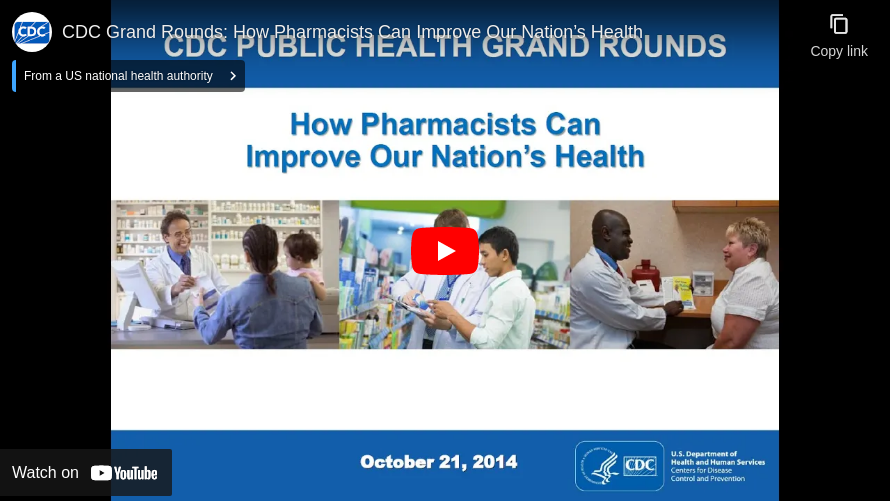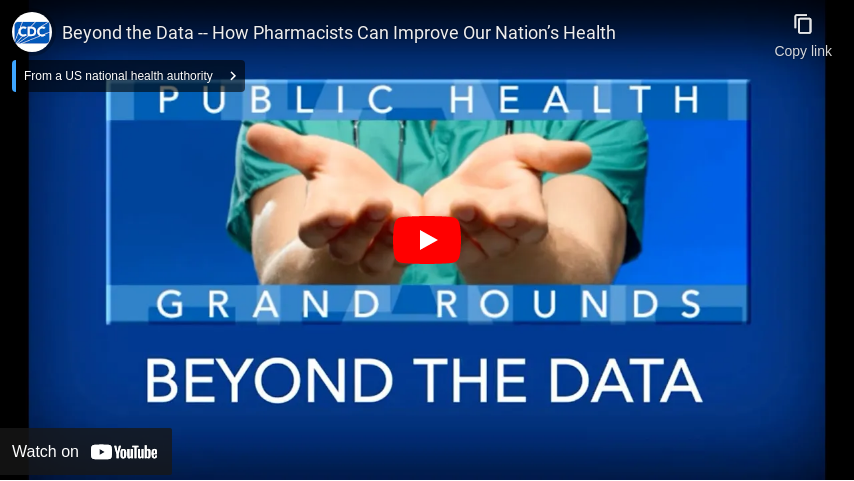How Pharmacists Can Improve Our Nation’s Health
Presented on .
The expanded role of 21st century pharmacists will position them to have greater impact in the shifting landscape of health care and public health. Beyond the dispensing of medications, pharmacists also provide a spectrum of prevention services to help improve health outcomes. In the United States, people with chronic conditions account for 91% of all prescriptions filled. By 2020, it is estimated that 157 million Americans will have at least 1 chronic non-infectious or infectious medical condition. By understanding and maximizing the role of pharmacists, opportunities exist to better use their knowledge and skills to improve our nation’s health.
New collaborative care models identify pharmacists as important contributors to the healthcare team. Enhanced training equips pharmacists with the necessary skills to provide a variety of preventive care and wellness services–increasing access to care for patients. For public health, incorporating pharmacists in team-based care increases patient awareness of the importance of medication adherence and further encourages and supports behavior change and self-management of many chronic illnesses and diseases.
In this session of Public Health Grand Rounds our speakers illustrated the impact of including pharmacists in team-based care, shared tools that CDC has developed to facilitate incorporating pharmacists in public health initiatives, and provided examples of how pharmacists are working in healthcare settings to prevent and manage diseases.
Dr. John Iskander and Dr. Lori Hall explore the impact of pharmacists on health care and public health when included as contributors to a patient’s healthcare team.
Pharmacists:
- Tend to be underutilized, despite their training and experience
- Are medication experts, but they do more than just dispense medication
Involving pharmacists in expanded roles:
- Increases the quality of care
- Improves patient control of disorders and illnesses
- Reduces healthcare cost
- CDR Michael Lee, PharmD, NCPS, BCPS
- Director, Pharmacy
Claremore Indian Hospital
- Anne Burns, RPh, BS
- Vice President, Professional Affairs
American Pharmacists Association
- Magaly Rodriguez de Bittner, PharmD, BCPS, CDE
- Professor and Chair, Department of Pharmacy Practice and Science
University of Maryland School of Pharmacy
- CDR Lori E. Hall, PharmD
- President, CDC Pharmacists Work Group
National Center for Chronic Disease Prevention and Health Promotion, CDC
- John Iskander, MD, MPH
- Scientific Director
- Phoebe Thorpe, MD, MPH
- Deputy Scientific Director
- Susan Laird, MSN, RN
- Communications Director
Get notified about the latest updates from Public Health Grand Rounds right in your inbox by setting up an alert today!
Get notified about the latest updates from Public Health Grand Rounds right in your inbox by setting up an alert today!Sign Up
Get notified about the latest updates from Public Health Grand Rounds right in your inbox by setting up an alert today!
- Presentation Slide Deck [1.73 MB, 60 Pages, HTML]
- Team Up. Pressure Down. Resources for Pharmacists
- A Program Guide for Public Health: Partnering with Pharmacists in the Prevention and Control of Chronic Diseases [3.89 KB, 20 Pages]
- For Nurses, Physician Assistants, and Other Providers [PDF - 308 KB]
Collaborative Practice Agreement Toolkits - For Pharmacists [PDF - 316 KB]
Collaborative Practice Agreement Toolkits - For Government and Private Payers [PDF - 308 KB]
Collaborative Practice Agreement Toolkits - For Decision Makers [PDF - 314 KB]
Collaborative Practice Agreement Toolkits

The US is in the grip of an epidemic of prescription drug overdoses. This mortality trend parallels a ten-fold increase in the medical use of opioid painkillers, such as oxycodone and hydrocodone. Learn about this complicated problem and how education, prevention, and enforcement is needed to reverse this epidemic.

Deaths from drug overdoses are the number one cause of injury death in the US. Most of these deaths are related to the misuse of prescription opioids and heroin. Women’s deaths from opioid overdose are increasing substantially. Learn about care and prevention approaches and the federal response to this disorder.

